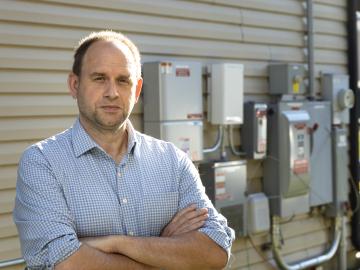
Filter News
Area of Research
- Advanced Manufacturing (1)
- Biological Systems (1)
- Biology and Environment (39)
- Building Technologies (3)
- Computational Engineering (1)
- Computer Science (3)
- Energy Science (65)
- Energy Sciences (1)
- Fusion and Fission (3)
- Fusion Energy (1)
- Isotopes (12)
- Materials (21)
- Materials for Computing (1)
- Mathematics (1)
- National Security (7)
- Neutron Science (6)
- Nuclear Science and Technology (4)
- Quantum information Science (3)
- Supercomputing (11)
News Type
News Topics
- (-) Bioenergy (40)
- (-) Buildings (31)
- (-) Cybersecurity (9)
- (-) Energy Storage (45)
- (-) Frontier (4)
- (-) Hydropower (8)
- (-) Isotopes (18)
- (-) Physics (20)
- (-) Quantum Science (16)
- (-) Space Exploration (10)
- 3-D Printing/Advanced Manufacturing (47)
- Advanced Reactors (15)
- Artificial Intelligence (25)
- Big Data (29)
- Biology (48)
- Biomedical (24)
- Biotechnology (11)
- Chemical Sciences (22)
- Clean Water (21)
- Composites (14)
- Computer Science (56)
- Coronavirus (17)
- Critical Materials (14)
- Emergency (1)
- Environment (88)
- Exascale Computing (4)
- Fossil Energy (1)
- Fusion (18)
- Grid (29)
- High-Performance Computing (23)
- Irradiation (2)
- ITER (4)
- Machine Learning (24)
- Materials (45)
- Materials Science (49)
- Mathematics (8)
- Mercury (7)
- Microscopy (22)
- Molten Salt (5)
- Nanotechnology (18)
- National Security (20)
- Neutron Science (37)
- Nuclear Energy (35)
- Partnerships (4)
- Polymers (15)
- Quantum Computing (6)
- Security (8)
- Simulation (17)
- Statistics (1)
- Summit (10)
- Transportation (48)
Media Contacts

Systems biologist Paul Abraham uses his fascination with proteins, the molecular machines of nature, to explore new ways to engineer more productive ecosystems and hardier bioenergy crops.

Oak Ridge National Laboratory scientists evaluating northern peatland responses to environmental change recorded extraordinary fine-root growth with increasing temperatures, indicating that this previously hidden belowground mechanism may play an important role in how carbon-rich peatlands respond to warming.

Joe Hagerman, ORNL research lead for buildings integration and controls, understands the impact building technology innovations can have during times of crisis. Over a decade ago, he found himself in the middle of one of the most devastating natural disasters of the century, Hurricane Katrina.

Researchers at Oak Ridge National Laboratory developed a method that uses machine learning to predict seasonal fire risk in Africa, where half of the world’s wildfire-related carbon emissions originate.

Oak Ridge National Laboratory scientists seeking the source of charge loss in lithium-ion batteries demonstrated that coupling a thin-film cathode with a solid electrolyte is a rapid way to determine the root cause.

In the search to create materials that can withstand extreme radiation, Yanwen Zhang, a researcher at the Department of Energy’s Oak Ridge National Laboratory, says that materials scientists must think outside the box.

Oak Ridge National Laboratory researchers have discovered a better way to separate actinium-227, a rare isotope essential for an FDA-approved cancer treatment.
An international team of scientists found that rules governing plant growth hold true even at the edges of the world in the Arctic tundra.

Oak Ridge National Laboratory researchers have developed a thin film, highly conductive solid-state electrolyte made of a polymer and ceramic-based composite for lithium metal batteries.



